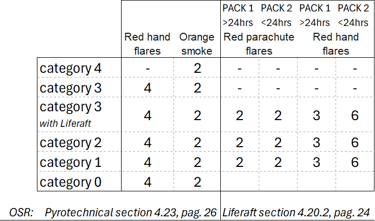To do list of June: Safety First, Fun Always!
Ahoy, sailors! As we set our sights on the upcoming sailing season, let’s make safety our first mate. And guess what? Retailers are rolling out the red carpet with promotions. It’s like they knew we were coming!
TO DO LISTS
5/31/20245 min read


Safety Checklists: Your Treasure Map to Safe Sailing
Ever heard of World Sailing, the global sailing association? They’re like the guardians of the galaxy, but for sailors. Every year, their team of experts fine-tunes safety regulations, incorporating the latest insights and tech. Imagine having a team of pros doing your homework!
Here’s how to navigate their treasure trove of safety checklists:
Download the latest Offshore Special Regulations.
It’s free and fresher than a sea breeze.Are you a monohull (Mo) sailor or a multihull (Mu) enthusiast? Choose your tribe!
Identify your sailing area, categorized from 0 (for the Captain Nemos out there) to 4 (perfect for a Sunday sail on the lake). In more detail:
Category 4: This is your chill Sunday sail on a lake. You’re close to shore, the waters are warm and protected, and you’re sailing in daylight. It’s like a leisurely stroll in the park, but on water.
Category 3: Now we’re getting adventurous. Imagine crossing the North Sea between The Netherlands and the UK. You’re crossing open water, but most of it is relatively protected or close to shorelines. It’s like a hike in the woods - you’re away from civilization, but not too far.
Category 2: Welcome to the big leagues, sailor! This is also for the Rolex Fastnet Racers among us, who are sailing from the Solent, to the Rock in the Irish Sea, and back towards Cherbourg in France.
Your trip is of an extended duration along or not far removed from shorelines or in large, unprotected bays or lakes. A high degree of self-sufficiency is required. It’s like a multi-day backpacking trip - you’re on your own, and you need to be prepared.
Category 1 and 0: These are the epic quests of sailing. You’re on long offshore journeys where self-sufficiency is key. You must be completely self-sufficient for extended periods of time, capable of withstanding heavy storms, and prepared to meet serious emergencies without the expectation of outside assistance.
Category 1 is like a long-distance road trip. You’re well offshore, and you need to be prepared for heavy storms and emergencies.
Category 0 is the ‘next-level’ trans-oceanic trip. You’re passing through areas where air or sea temperatures are likely to be less than 5°C (41°F) other than temporarily. Sort of an expedition to the Arctic - you’re on your own and you need to be ready for anything.
Remember, sailor, knowing your category is like having a map - it helps you prepare for the journey ahead. So, plot your course, check your gear, and set sail for adventure!
Gear up and Keep Everything Shipshape
Navigating the sea of safety gear can feel like sailing in a storm.
But fear not, we’re here to guide you through the essentials.
Lifevest or Buoyancy Aid: It’s simple - wear it and make sure it works. Choose one that fits well and suits your needs and where you are. Remember, even your furry first mate needs one!
Keep it shipshape by rinsing off the salt, manually inflating it, checking the light, and servicing it every 3 years.
TIP: The RYA advises against wearing a 275 lifejacket as it can obstruct you when getting into a life raft.
Liferaft
The golden rule - stay on board unless you have to ‘step up’ into your liferaft. Make sure it fits your crew size or more. When choosing a liferaft, consider the experts’ opinion and check what is required by World Sailing. Pick a size for the number of crew, decide whether you prefer a valise or canister, and choose a pack based on your journey. Remember, a liferaft should be serviced at a manufacturer-authorized service station and you must keep servicing certificates on board. [Have a sneak-peak at 'Offshore Special Regulations page 23, section 4.20']
Danbuoy and Lifebuoy
If you have an inflatable danbuoy or lifebuoy, there’s work to be done. Check and service your danbuoy or lifebuoy regularly, just like your inflatable lifevest.
‘Fireworks’ or Pyrotechnic and Light Signals
As a general rule, pyrotechnic signals should not be older than the stamped expiry date or if no expiry date stamped, not older than 4 years.
In below overview, see what the specialists of World Sailing require from the racers. As a rule of thumb, we consider that a good recommendation to the rest of us, sailors. Just check what category your trip might fit in.
[Have a sneak-peak at Offshore Special Regulations page 24 and 26, section 4.20.2 and section 4.23]
Training and Certification: The ABCs of Safety
Depending on your sailing category, you might need to add a few more letters to your sailing alphabet:
First Aid: It’s like a band-aid for your boat. Mandatory for many of us racing, and needs renewal every three years. For the racers, check your category on what is required today.
VHF License: Hooking a VHF to your vessel? You'll need a license. It's only usable by a licensed sailor. Many harbors and marinas require you to use a VHF, so your license is key. Renting a yacht in the Mediterranean? Many need a VHF license. Choose one with GMDSS, like the RYA short range certificate or the Dutch MarcomB. Once you've got it, it's yours for life. It’s your ticket to the airwaves. Don’t leave the dock without it!
Offshore Personal Survival Training: Learn to handle emergencies like a pro; a survival reality show, but without the cameras. This training is like a trusty compass in a storm, preparing you for emergencies at sea. It's a good idea for all sea dogs to know their way around a crisis.
For racers of category 0, 1, 2 and 3 (double-handed), it's not just a good idea, it's mandatory. And remember, this certificate needs renewing every 5 years.
Check out World Sailing approved training centers in your country.Yachtmaster (RYA): It’s not just a title, it’s a responsibility. More and more rental agencies are asking for this treasure, so it's a good one to have in your chest.
But beware, this isn't a journey for the faint-hearted. You'll also need a 1st aid and VHF license.
So, check in time if you need one, to make sure nothing spoils your holiday.National Licenses or International Certificate of Competence (ICC): They are your boat’s passport to the open seas. Especially handy for rental yachts abroad. So, before you set sail, make sure you've got your national licence or ICC in your captain's chest.
Remember, safety isn’t just a checklist, it’s a mindset. Equip yourself with the right knowledge and gear, and you’ll be ready for a safe and enjoyable sailing season. After a bit of shopping with your retailers and all the safety checks and certifications done, you’re ready to set sail. Here’s to an excellent season.
Anything else we can assist or advice you with?
Our experts and designers are ready to help you.
Now, anchors aweigh, sailors!
Photo by Alain Gehri on Unsplash



www.projectmadeinholland.com
team@projectmadeinholland.com
VAT# NL860494767B01
Chamber of C.# 76064387
